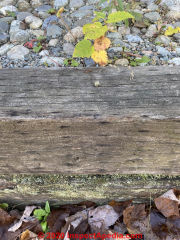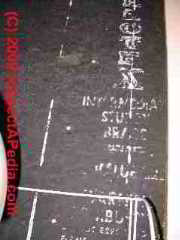 Creosote Hazard FAQs
Creosote Hazard FAQs
Q&A on the history, uses, carcinogenicity, bans of creosote
- POST a QUESTION or COMMENT about creosote, types, uses, hazards
Creosote history & hazard questions & answers.
This series of articles gives in-depth advice on indoor and building related environmental hazard inspection, detection, remediation: Environmental Hazard Testing, Effects, Remedies, Prevention Procedures. Indoor Contaminant Detection, Testing, Cleanup, Illness, Symptoms, Diagnosis.
Also try the page top or bottom SEARCH BOX as a quick way to find information you need.
InspectAPedia tolerates no conflicts of interest. We have no relationship with advertisers, products, or services discussed at this website.
- Daniel Friedman, Publisher/Editor/Author - See WHO ARE WE?
Creosote Questions & Answers
 These questions & answers about creosote and creosote hazards were posted orignally
These questions & answers about creosote and creosote hazards were posted orignally
at CREOSOTE HAZARDS - topic home; be sure to read that article.
On 2021-06-15 by inspectapedia.com.moderator (mod) - how much creosote is actually reaching out in wet weather
@Edy Psschall,
It's perfectly fair to ask the question but it's not one that can be answered based on a brief text. The question would be how much creosote is actually reaching out in wet weather and where does that lead shade run when it does
On 2021-06-14 by Edy Psschall - risks from neighbor's railroad ties?
I bought a house that is next door to people that put down railroad ties on the borderbof my lot that they used for flowers and hedges. It is several feet long. How dangerous is this to be around? What can I do about situation?
On 2021-01-07 by Anonymous
@danjoefriedman,
Ok thank you again
On 2021-01-07 by danjoefriedman (mod)
Just look for oil spills stains around the oil tank or the routing of the fuel line into the building. If those areas are all clean and wouldn't worry about it further.
On 2021-01-07 by Anonymous
Thanks for your response!
The tank was recently removed ( we switched to propane), so this area that tank was housed in is now empty. The floor of that area looks like cement. Next time I’m there I can check for anything pointing to a previous leak. Anything in particular that I should be looking for?
On 2021-01-06 by danjoefriedman (mod) - creosote treated wood around oil tank?
Anon
If you don't smell creosote then there's probably no high level of airborne creosote volatiles being released. However for the circumstance you described by no means what I assume a thing about the use of creosote.
I would however make sufficient opening to check thoroughly for previous oil leaks. Be sure to check the condition of the tank.
At OIL TANK INSPECTION & TROUBLESHOOTING you'll find articles about oil tank leaks, fill and vent pipe leaks, and oil fuel supply piping leaks: detection, causes, repairs, risks.
On 2021-01-06 by Anonymous
Hello-
I recently purchased a home that used to house an oil tank that fueled furnace. Oil tank had been framed in and sided to appear that it is part of the house. This oil tank area is separated from the indoor living space by a wall.
I’m questioning if some of the wood in this space may have been once treated with creosote due to the smell when I enter through the access door.
When inside the house itself, I do not smell creosote. I am assuming that if there is no noticeable smell in the living space, then risk of inhalation exposure would be felt to be relatively low. Does this sound accurate?
On 2020-10-18 - by (mod) -
creosote hazard worry can provoke overly-cautious consultant advice: the OPM Problem Thanks Chris. I'm not personally worried one iota about a complaint; either gripes help us see where we need to improve our data, research, or response, or we learn something else;
Thanks Chris. I'm not personally worried one iota about a complaint; either gripes help us see where we need to improve our data, research, or response, or we learn something else;
But on occasion it becomes appropriate to caution a nervous client or reader about what can happen and what sort of advice they're going to get.
I'm telling you something, with this OPM discussion, that most consultants would not, for various reasons, feel able or comfortable trying to explain.
For you I recommend reading
TECHNICAL GUIDE 146 GUIDE FOR HANDLING, REUSE, AND DISPOSAL OF CHEMICALLY TREATED WOOD MATERIAL [PDF] (2017) U.S. Army Public Health Center, APHC,
and
MANAGEMENT of USED TREATED WOOD PRODUCTS [PDF] TWLCMC
Excerpt:
In 1992 EPRI completed research on creosote treated wood poles and crossarms and foundextract levels to be well below the TCLP limits for cresols. The study examined the TCLP characteristics of 54 diverse samples provided by 15 utilities.
The samples were taken from 17 poles and 6 crossarms, ranging in age from 10 to 57 years, from Douglas fir, Southern pine,and Western red cedar. The results found a mean concentration of total cresols in the TCLPextracts of 1.61 mg/l (i.e., 1.61 parts per million), compared to a regulatory level of 200 mg/l.
The results range from below detection limits to a high of 14.95 mg/l. (See Figure 2.)
The impact of this research, according to EPRI, is as follows:Thus, these results provide the basis for utilities to continue managing creosote-treated polesand crossarms as non -hazardous solid waste and to forgo expenses and operational hindrances associated with TCLP testing.
On 2020-10-18 by Chris
Thank you, I understand. You provide a great free resource to many and I would never think of complaining about any input given here. I think my nervousness about the issue caused me to ask some unneeded questions. Keep up the good work, thank you again.
On 2020-10-18 (mod) - OPM advice for gray landsape ties that worry property owner about creosote hazards
Chris
Typically people remove creosote treated wood from areas where it's likely to be a hazard such as in a children's playground or where runoff is likelyl to contaminante a nearby water source.
1. The gray color argues against your wood ties being creosote - which is normally brown or black and brown
2. You have run into the OPM problem that I describe at OTHER PEOPLE's MONEY
If you press a consultant or purported expert beyond what they can reasonably be expected to know or promise in any absolute term they become guarded and ultimately will feel a strong impetus to toss in the towel, simply telling you to do what is absolute safest - for themselves, avoiding any possible future complaint from you that they didn't give you sufficiently safe or proper advice. The result is they will spend your time, money, trouble, effort, to reduce their risk, even though they themselves consider the recommended steps overkill or unnecessary.
That pressure produces this final OPM advice for you:
Yes you should remove all of the landscape ties, having them professionally lifted, packaged, and hauled to an acceptable construction or household waste site, since you don't want to simply store them elsewhere on your property. You should also have your well tested for an appropriate range of potential biological and chemical contaminants, using test screens recommended by your local water testing lab, but including organic contaminants such as creosote and other wood preservatives, fungicides, pesticides.
Watch out:
Do not attempt to burn wood waste as doing so may release toxic chemicals in the smoke and ash from such fire.
In addition, depending on your water test resutls, you may need a water purification and treatment system if not regular testing if you want to assure that your drinking water remains safe.
When the in-question landscape ties have been removed, to allay your Environmental concerns for your pets, you should have soil testing performed, again with advice from your local environmental test lab, to be absolutely certain that the soil around your home is free of contaminants and safe for your dogs as well as for humans.
Watch out: if your landscape ties are not creosote-treated, depending on their age and just how they were treated with a wood preservative, if CCA (chromated copper arsenate) was used, there could be a copper or an arsenic hazard such as arsenic from physical contact or arsenic contamination of nearby water supplies.
Finally, check with your own local and state or provincial environmental and health department authorities to be sure that your actions are in compliance with appropriate laws.
On 2020-10-18 by Chris - IF a wall like this was creosote treated, would removal be preferred over letting it be?
Thank you, I’ll be sure to test and protect the well as you mentioned.
I ask [for a third time] about replacement of this retaining wall aside from concern about the well.
IF a wall like this was creosote treated, would removal be preferred over letting it be?
I ask because I know some hazardous material is better left undisturbed. I don’t plan on touching this wall very much but we have a couple dogs that spend a lot of time outside may be in more contact than I. Also, my sniff test did show a smell similar to other creosote treated wood.
On 2020-10-16 - by (mod) -
I don't have an opinion about the wood beyond what we've already discussed.
As you were concerned about the possibility of well water contamination, although we have not established creosote,
I did emphasise a couple of times thi importantce of proper water testing and well protection.
On 2020-10-16 by Chris - so do I have to remove these landscape ties or not?
Sorry to be redundant. Would you recommend removal of this wood in this situation if it was railroad ties? Or is leaving as is better? Thanks
Just did the sniff test. Definitely smelled something once I put my nose right up to it. To test it out, I also smelled a nearby telephone pole that I know was put in creosote at one point. Same smell. With this being the case, what would you say would be the best fix for this? Replace wall? Anything in relation to The well that would make sense to do in this situation?
On 2020-10-11 by (mod) - creosote treated timbers are brown or black and brown, not gray
Did you try the sniff test? Creosote, even on very weathered wood, still has a distinctive odor.
Usually weathered creosote-coated wood never turns so gray as your ties, and as we've said a few times, the dimensions do NOT argue for RR ties nor for creosote-treated wood.
On 2020-10-11 by Anonymous - dimensions of my landsacpe ties
Ok thank you. I should have also mentioned that some ties were rectangular (about 6.5 x 9 or so. Several ties be were exact inches but 6.5 by 8.5 for example.
On 2020-10-11 - by (mod) -
water contamination & other hazards from railroad ties & landscape ties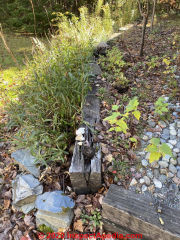 Chris:
Chris:
The proper way to protect your well from contaminants that could leach from the ground surface is to properly construct the well to not allow surface water to leak into the water supply, and to test the water periodically for contaminants - testing at least for bacteria that can serve as a telltale indicator of surface runoff entering the well.
Besides creosote contaminating soil and water (and skin and people and other animals), older landscape ties may have used toxic wood preservatives such as copper arsenate. Those are no longer used.
The small "cracks" you see running parallel to the wood grain are artifacts of the machinery used to plane and move the wood through its production process. I've seen those mostly on landscape timbers but also on some railroad ties.
The color (gray), dimensions (not those of railroad ties) and absence of visible creosote argue (no black or brown tarry deposits) against your wood landscaping timbers being railroad ties.
If the wood is pretty soft in un-damaged areas, it's not a railroad tie. Nor do we commonly find rot on creosote treated wood.
On 2020-10-11 by Chris
I just measured. I’m seeing varying sizes but the lengths seem uniform at 101 inches (8.4 feet).
If these were railroad ties, is it probable this would effect the well water? Any other issue with these ties if I left them as is? Thank you ...
Ok. I don’t see creosote oozing it in places as you sometimes see either. I took a close up pic and wonder if the small cracks/imprints on the tie are made from the metal mesh (probably not the right term) I recall seeing on railroad tracks. Let me know what you think. Thank you!
On 2020-10-11 - by (mod) -
how to identify railroad ties from landscape ties or timbersI'm not dead certain of your photo Chris but that looks to me more like a "landscape tie" that is sometimes sold for use just as we see it.
One way you can make a determination of whether or not those are actual real "railroad ties" other than by spotting creosote would be to measure your wooden ties.
Railroad tie dimensions: A standard wooden railroad tie is normally 7" x 9" in cross section and is 8' 6" in length.
Landscape timber dimensions: Typical "landscape ties" are 8" x 8" (square) in cross section but also sold in 9" x 9" and 7" x 7" and 6" x 6" in cross section and sometimes even in smaller 4" x 6" in cross section.
The standard length of landscape ties is 8' - shorter than a railroad tie.
Unlike true railroad ties, a landscape tie is usually square in cross section OR is sold with two rounded "log-like" faces.
While some wood associations such as the Wester Red Cedar lumber association have offered a standard definition of landscape timbers or ties, there is not much industry agreement; typical building suppliers like Home Depot and Lowes call any large wooden timber sold for landscape purposes as a "landscape tie".
By the way your siding is a bit close to ground and the landscape ties and stoe form a natural water trap against the foundation; be sure to keep your gutters from spilling into such areas.
On 2020-10-11 by Chris
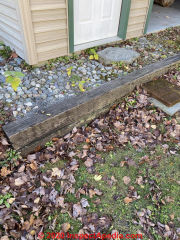 Ok, let me try to add this pic
Ok, let me try to add this pic
On 2020-10-11 by - by (mod) -
Try using the "add image" button, Chris, to add an image file (.jpg or .gif or .jpeg etc).
If the wooden ties are indeed real railroad ties they'd have been treated with creosote.
See details and some example photos of creosote-treated railroad ties at CREOSOTE HAZARDS - topic home
On 2020-10-11 by Chris
Hello, my question pertains use of old railroad ties on residence. Just moved into house recently I noticed a small retaining wall which appears to be built from what looks like all railroad ties. I have attached an image for review.
This wall is approximately 20 feet from where the well is
And I’m wondering if there is any need for concern in the event that these were treated with creosote at one time. Thank you
This Q&A were posted originally
at ENVIRONMENTAL HAZARDS at BUILDINGS
On 2019-08-17 by (mod) - Creosote Hazards, Bans, Management on Buildings
Anon:
Creosote, basically a wood tar or coal tar product, or oil tar product, is a probable carcinogen that, when present on a building surface is most-likely to be hazardous when in contact with the skin.
I said before that creosote was never a "board" or "siding" product, it was a coating used on beams and posts and piers, principally in ground contact, to reduce fungal attack or rot.
If it's under your siding I'd be surprised, but in any event in that location you'll not be likely to come into contact with it.
See this Creosote hazard advice for more details
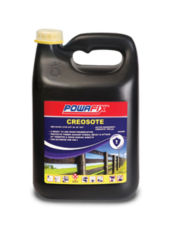 CREOSOTE ADVICE [PDF] New Jersey DOH https://inspectapedia.com/Environment/Creosote-Advice-NJ-DOH.pdf
CREOSOTE ADVICE [PDF] New Jersey DOH https://inspectapedia.com/Environment/Creosote-Advice-NJ-DOH.pdf
CREOSOTE HAZARD INFORMATION, US EPA [PDF] https://inspectapedia.com/Environment/Creosote-Hazard-EPA.pdf
The use of creosote fell in the U.S. beginning with the US EPA creosote ban proposal in August 1984
Creosote was banned in the EU in 2003
(OSHA) has set a permissible exposure limit of 0.2 milligrams of coal tar creosote per cubic meter of air (0.2 mg/m3) in the workplace during an 8-hour day, and the Environmental Protection Agency (EPA) requires that spills or accidental releases into the environment of one pound (0.454 kg) or more of creosote be reported to them.-Wikipedia
Watch out: creosote is still produced and used in some countries such as South Africa - as we show here.
PowaFix timber treatment products provides this additional information
- PowaFix CREOSOTE TIMBER TREATMENT TECHNICAL DATA [PDF] (2017) PowaFix, website: www.powafix.co.za retrieved anew 2020/10/11, original source: https://www.powafix.co.za/wp-content/uploads/2017/08/TDS-CREOSOTE.pdf
- PowaFix CREOSOTE SAFETY DATA SHEET [PDF] Powafixcc7 Transport Drive Prospecton Durban, South Africa, Tel: 0860 254620 retrieved 2020/10/11 original source: https://www.powafix.co.za/wp-content/uploads/2017/08/SDS-Creosote.pdf
 Working with my dad in the 1940s (that's me in diaper in this photo of my earliest fun with creosote) and early 1950s we were in frequent contact with creosote on the pilings and beams of docks along the Rappahannock river in Virginia. Painting and slathering on creosote as a wood preservative, and decades before its cancer risk was publicized, we learned early-on to avoid any skin contact with cresosote.
Working with my dad in the 1940s (that's me in diaper in this photo of my earliest fun with creosote) and early 1950s we were in frequent contact with creosote on the pilings and beams of docks along the Rappahannock river in Virginia. Painting and slathering on creosote as a wood preservative, and decades before its cancer risk was publicized, we learned early-on to avoid any skin contact with cresosote.
We also found that particularly fresh creosote-treated wood off-gassed an irritating smell.
While we have no scientifically rigorous evidence, it's possible that a combination of physical injury to his hand during building and contact with creosote was a factor in my dad's development of a skin cancer on his thumb that ultimately led to his death decades later.
Also see
- RAILROAD TIES or RAILWAY SLEEPERS as WASTE [PDF] EPA Ireland https://inspectapedia.com/Environment/Railway-sleepers-waste-EPA-Ireland.pdf
- CREOSOTE HEALTH EFFECTS [PDF] ATSDR https://inspectapedia.com/Environment/Creosote-Health-Effects-ATSDR.pdf
On 2019-08-17 by Anonymous - creosote board on a building exterior?
In my question just below, when I say “exteriors”, I mean just under siding of house. Thanks
Is creosote application common in exteriors and is there any specific guidance if this sort of application is discovered? Thank you
This Q&A were posted originally
at ENVIRONMENTAL HAZARDS at BUILDINGS
On 2019-08-16 by (mod) - . Contractor stated he thought it was “creosote board”.
Creosote was never a "board" but creosote was used as a paint-on preservative for wood in contact with soil or water and creosote-impregnated wood was used for pilings and telephone poles. Cresote is a carcinogen.
Creosote treatments for wood in North America were banned as of June 2003.
Creosote and other tarry or dark coatings were also used on some fiberboard sheathing and insulation products. (Many were treated with water-resisting waxes, not creosote nor tar).
See examples at FIBERBOARD SHEATHING IDENTIFICATION
and at FIBERBOARD SHEATHING INGREDIENTS
On 2019-08-16 by Anonymous - Contractor stated he thought it was “creosote board”.
A friend of mine had a redo of his front porch area. After removal of small section siding material near foundation, friend noticed wood underneath that siding had a darker look to it than expected. Contractor stated he thought it was “creosote board”.
Friend said that the corresponding interior framing near ceiling level appears as normal color wood.
Thus, it appears that this creosote board was used only on exterior. House built in the 70’s. Was this common in that era and are there any issues with this external application?
Question: how can I get rid of creosote odors in my basement?
2019/11/16 Anonymous asked by private email
bought a house several months ago and discovered that an addition (put on some 15-20 years ago) must have been coated (the wood used to build with in the crawl space) with creosote…several construction people have said as much.
Is there a way to rid that space of the creosote odor? It is not as strong as it was initially as I’ve had the wood in the cold air return clad in metal and caulked.
Can you suggest other treatment? How dangerous is that smell considered to be.
Thank you for any assistance or answers you can provide.
Reply: Dealing with creosote odors in your home
Creosote Volatiles Exposure Assessment
The presence of a creosote odor could indeed mean that occupants are inhaling harmful creosote-produced gases or gases that are at the least a respiratory irritant that could be a problem for people who are sensitive such as asthmatics or infants or the elderly.
But no one can assess "how dangerous" your creosote odor or smell exposure is merely from an e-text: the dose, the exposure level, the exposure duration, and the physical health vulnerability of building occupants are examples of the variables involved.
The World Health Organization and others have commented on the difficulty of actually surveying the level of creosote exposure through air inhalation.
Exposure to cresols can occur through air, water, or food. The median air concentration of o-cresols was 1.578 ug/m3 (0.359 ppb) for 32 source dominated sites in USA. ...
The general population can be exposed to cresols through air inhalation, drinking-water, food, and beverage ingestion, and dermal contact.
In general, the lack of adequate monitoring data makes the quantitative estimate of daily intakes of cresol from these sources impossible. Occupational exposure levels in air as high as 5.0 mg/m3 have been reported. (WHO 1996)
There is ample research on the toxicity of exposure to coal tar pitch volatiles.
Numerous citations are in "Table 3-6. Genotoxicity of Coal Tar Creosote, Coal Tar, Coal Tar Pitch, or Coal Tar Pitch Volatiles In Vivo" in the 2002 US DEHS toxicity profile I will cite below.
From that my OPINION is that "prudent avoidance" of exposure to creosote fumes or smells is in order. But again, the dose makes the poison.
Options to get rid of creosote odors include
1. Identify and remove the creosote-treated materials - this is the best approach and even this approach may be insufficient as creosote volatile organic compounds in gas form may have been absorbed by some other building materials.
Once the creosote-treated wood materials have been removed,
this SMELL PATCH TEST to FIND ODOR SOURCE may help identify materials such as drywall or furnishings that have absorbed the creosote odors and that may need to be treated or removed.
2. Seal odor-emitting surfaces with a fire-odor sealant or similar sealant paint as we discuss
Research on Health Hazards of Breathing Creosote or coal tar pitch volatiles or VOCs
There has been research (with mixed conclusions) on the health effects of breathing creosote off-gassing products, though principally in more-extreme conditions. See
- ATSDR Agency for Toxic Substances and Disease Registry. "Toxicological profile on CD for phenols (1989), cresols (1992)." (1997).
- US DEHS, TOXICOLOGICAL PROFILE FOR WOOD CREOSOTE, COAL TAR CREOSOTE, COAL TAR, COAL TAR PITCH, AND COAL TAR PITCH VOLATILES, [PDF] U.S. Department Of Health And Human Services Agency for Toxic Substances and Disease Registry
Division of Toxicology/Toxicology Information Branch
1600 Clifton Road NE, E-29
Atlanta, Georgia 30333 (2002)
Excerpts:
This profile is specifically about the toxicity of wood creosote, coal tar creosote, coal tar, coal tarpitch, and coal tar pitch volatiles, ... The Agency for Toxic Substances and Disease Registry (ATSDR) Toxicological Profile forPolycyclic Aromatic Hydrocarbons (1995), the ATSDR Toxicological Profile for Cresols(1992), and the ATSDR Toxicological Profile for Phenol (1998) provide more information onthese chemicals.
For more information on the chemical and physical properties of creosotes,coal tar, coal tar pitch, and coal tar pitch volatiles, see Chapter 4. For more information on thesesubstances in the environment, see Chapters 5 and 6.
Most people are exposed to very low levels of creosote. People who are exposed to higher concentrations than the general population are those exposed to creosote in their jobs and those who use products that contain creosote to improve a health problem such as eczema or psoriasis.
If your doctor finds that you have been exposed to significant amounts of creosote, coal tar, coal tar pitch, or coal tar pitch volatiles, ask whether your children might also be exposed.
Your doctor might need to ask your state health department to investigate.
Families may reduce the risk of exposure to coal tar creosote, coal tar, coal tar pitch, and coal tar pitch volatiles in several ways if they find that they are at risk of such exposures. - Beard, Rodney R. "A Doubt About Toxic Effects of Creosote Fumes." JAMA 194, no. 7 (1965): 833-833.
- Dahlgren, James, Raphael Warshaw, John Thornton, Pamela Anderson-Mahoney, and Harpreet Takhar. "Health effects on nearby residents of a wood treatment plant." Environmental research 92, no. 2 (2003): 92-98.
- Ventura, Francesc, Ma Rosa Boleda, Roger Lloret, and Jordi Martin-Alonso. "Strategies for the identification of compounds causing odours in water: a study of creosote spills." Water Research 32, no. 2 (1998): 503-509.
On 2019-08-16 by Anonymous - Creosote board used on the exterior of a home under siding: Dangerous?
A friend of mine had a redo of his front porch area. After removal of small section siding material near foundation, friend noticed wood underneath that siding had a darker look to it than expected. Contractor stated he thought it was “creosote board”.
Friend said that the corresponding interior framing near ceiling level appears as normal color wood. Thus, it appears that this creosote board was used only on exterior. House built in the 70’s. Was this common in that era and are there any issues with this external application?
On 2019-08-16 by (mod) -
Creosote was never a "board" but creosote was used as a paint-on preservative for wood in contact with soil or water and creosote-impregnated wood was used for pilings and telephone poles. Cresote is a carcinogen.
Creosote treatments for wood in North America were banned as of June 2003.
However it's possible that your contractor was referring to an insulating board used as sheating on building walls and occasionally even on roofs. Those products are described at
Those building sheathing products, or some of them used a brown coating or impregnation for water-proofing but they did not use creosote - unless the liquid creosote coating was field-applied by a third party builder or installer.
Some photos of your building siding and sheathing board would be helpful.
On 2019-08-16 by Anonymous
Is creosote application common in exteriors and is there any specific guidance if this sort of application is discovered? Thank you
In my question , when I say “exteriors”, I mean just under siding of house. Thanks
On 2019-08-17 by (mod) -
Anon:
Creosote, basically a wood tar or coal tar product, or oil tar product, is a probable carcinogen that, when present on a building surface is most-likely to be hazardous when in contact with the skin.
I said before that creosote was never a "board" or "siding" product, it was a coating used on beams and posts and piers, principally in ground contact, to reduce fungal attack or rot.
If it's under your siding I'd be surprised, but in any event in that location you'll not be likely to come into contact with it.
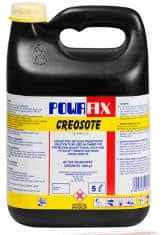 See our CREOSOTE HAZARD ADVICE - this topic's home page for more details
See our CREOSOTE HAZARD ADVICE - this topic's home page for more details
The use of creosote fell in the U.S. beginning with the US EPA creosote ban proposal in August 1984
Creosote was banned in the EU in 2003
(OSHA) has set a permissible exposure limit of 0.2 milligrams of coal tar creosote per cubic meter of air (0.2 mg/m3) in the workplace during an 8-hour day, and the Environmental Protection Agency (EPA) requires that spills or accidental releases into the environment of one pound (0.454 kg) or more of creosote be reported to them.-Wikipedia
Watch out: creosote is still produced and used in some countries such as South Africa
Also see
RAILROAD TIES or RAILWAY SLEEPERS as WASTE [PDF] EPA Ireland https://inspectapedia.com/Environment/Railway-sleepers-waste-EPA-Ireland.pdf
CREOSOTE HEALTH EFFECTS [PDF] ATSDR https://inspectapedia.com/Environment/Creosote-Health-Effects-ATSDR.pdf
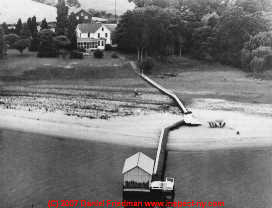 PS:
PS:
Working with my dad in the 1940s and early 1950s we were in frequent contact with creosote on the pilings and beams of a long dock extending out into the Rappahannock river in Dunnsville Virginia.
The white surface in the photo of this long walkway and creosote-painted pier was a white canvas strip installed after suffering creosote burns on the bottom of our bare feet.
[Click to enlarge any image]
Painting and slathering on creosote as a wood preservative, and decades before its cancer risk was publicized, we learned early-on to avoid any skin contact with cresosote. When we got creosote on our skin - as happened when we painted the pier boards or piling tops with creosote, it burned like the devil.
We also found that particularly fresh creosote-treated wood off-gassed an irritating smell that might have been unsafe.
While we have no scientifically rigorous evidence, it's possible that a combination of physical injury to his hand (hammer-smashed thumb) during building and contact with creosote (a known carcinogen) was a factor in my dad's development of a skin cancer on his thumb that ultimately led to his death decades later.
See also
- BURMA SHAVE - life along the Rappahannock
On 2019-08-17 by Anonymous
Thank you sir the info, very helpful!
...
Continue reading at CREOSOTE HAZARDS or select a topic from the closely-related articles below, or see the complete ARTICLE INDEX.
Or see these
Recommended Articles
- CHIMNEY STAINS & LEAKS
- CREOSOTE FIRE HAZARDS
- FIRE & SMOKE ODOR REMOVAL
- SMELL PATCH TEST to FIND ODOR SOURCE
Suggested citation for this web page
CREOSOTE HAZARD FAQs at InspectApedia.com - online encyclopedia of building & environmental inspection, testing, diagnosis, repair, & problem prevention advice.
Or see this
INDEX to RELATED ARTICLES: ARTICLE INDEX to BUILDING ENVIRONMENT
Or use the SEARCH BOX found below to Ask a Question or Search InspectApedia
Ask a Question or Search InspectApedia
Try the search box just below, or if you prefer, post a question or comment in the Comments box below and we will respond promptly.
Search the InspectApedia website
Note: appearance of your Comment below may be delayed: if your comment contains an image, photograph, web link, or text that looks to the software as if it might be a web link, your posting will appear after it has been approved by a moderator. Apologies for the delay.
Only one image can be added per comment but you can post as many comments, and therefore images, as you like.
You will not receive a notification when a response to your question has been posted.
Please bookmark this page to make it easy for you to check back for our response.
IF above you see "Comment Form is loading comments..." then COMMENT BOX - countable.ca / bawkbox.com IS NOT WORKING.
In any case you are welcome to send an email directly to us at InspectApedia.com at editor@inspectApedia.com
We'll reply to you directly. Please help us help you by noting, in your email, the URL of the InspectApedia page where you wanted to comment.
Citations & References
In addition to any citations in the article above, a full list is available on request.
- In addition to citations & references found in this article, see the research citations given at the end of the related articles found at our suggested
CONTINUE READING or RECOMMENDED ARTICLES.
- Carson, Dunlop & Associates Ltd., 120 Carlton Street Suite 407, Toronto ON M5A 4K2. Tel: (416) 964-9415 1-800-268-7070 Email: info@carsondunlop.com. Alan Carson is a past president of ASHI, the American Society of Home Inspectors.
Thanks to Alan Carson and Bob Dunlop, for permission for InspectAPedia to use text excerpts from The HOME REFERENCE BOOK - the Encyclopedia of Homes and to use illustrations from The ILLUSTRATED HOME .
Carson Dunlop Associates provides extensive home inspection education and report writing material. In gratitude we provide links to tsome Carson Dunlop Associates products and services.


